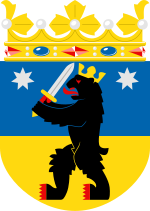Merikarvia
Merikarvia (Swedish: Sastmola) is a municipality of Finland.
Merikarvia Sastmola | |
|---|---|
Municipality | |
| Merikarvian kunta Sastmola kommun | |
 Coat of arms | |
 Location of Merikarvia in Finland | |
| Coordinates: 61°51.5′N 021°30′E | |
| Country | |
| Region | Satakunta |
| Sub-region | Pori sub-region |
| Charter | 1639 |
| Government | |
| • Municipal manager | Pentti Ala-Luopa |
| Area (2018-01-01)[1] | |
| • Total | 1,246.22 km2 (481.17 sq mi) |
| • Land | 446.04 km2 (172.22 sq mi) |
| • Water | 800.2 km2 (309.0 sq mi) |
| Area rank | 194th largest in Finland |
| Population (2019-01-31)[2] | |
| • Total | 3,111 |
| • Rank | 226th largest in Finland |
| • Density | 6.97/km2 (18.1/sq mi) |
| Population by native language | |
| • Finnish | 99.1% (official) |
| • Swedish | 0.3% |
| • Others | 0.6% |
| Population by age | |
| • 0 to 14 | 13.9% |
| • 15 to 64 | 59% |
| • 65 or older | 27.1% |
| Time zone | UTC+02:00 (EET) |
| • Summer (DST) | UTC+03:00 (EEST) |
| Municipal tax rate[5] | 19.5% |
| Climate | Dfc |
| Website | www.merikarvia.fi |
It is located in the Satakunta region. The neighboring municipalities are Isojoki, Kristinestad, Pomarkku, Pori and Siikainen.
The municipality has a population of 3,111 (31 January 2019)[2] and it covers an area of 1,246.22 square kilometres (481.17 sq mi), of which 800.2 km2 (309.0 sq mi) is water.[1] The population density is 6.97 inhabitants per square kilometre (18.1/sq mi).
The municipality is unilingually Finnish. The coastline was formerly Swedish-speaking. Merikarvia is known by the Oura Archipelago, which is part of the Bothnian Sea National Park.
History
The area has been inhabited since as early as 1800 BC. There are grave sites from the Bronze and Iron Ages within the municipality. Most of the cairns are located in Tuorila village located east of the municipal center.
The birth of the earliest villages in Merikarvia - Kasala, Riispyy, Ala- and Yli-Kylä, and Köörtilä - is dated to between the 13th and 14th centuries. As a separate municipality, Merikarvia has existed since 1865.
The first church in Merikarvia was built in 1776 and was named after the queen consort of Sweden at the time, Sofia Magdalena. The church, still in use today, was finished in 1899.
As a coastal municipality, Merikarvia largely lived from the sea until modern times. Fishing, sawmills and shipyards were common businesses until the end of the 19th century.
Politics
Results of the 2011 Finnish parliamentary election in Merikarvia:
- Centre Party 35.7%
- True Finns 23.7%
- Social Democratic Party 18.6%
- National Coalition Party 11.3%
- Left Alliance 6.1%
- Christian Democrats 2.6%
- Green League 1.7%
Sights
- Lankoski rapids
- The church of Merikarvia
- Oura Archipelago
References
- "Area of Finnish Municipalities 1.1.2018" (PDF). National Land Survey of Finland. Retrieved 30 January 2018.
- "Suomen virallinen tilasto (SVT): Väestön ennakkotilasto [verkkojulkaisu]. Tammikuu 2019" (in Finnish). Statistics Finland. Retrieved 15 March 2019.
- "Population according to language and the number of foreigners and land area km2 by area as of 31 December 2008". Statistics Finland's PX-Web databases. Statistics Finland. Retrieved 29 March 2009.
- "Population according to age and gender by area as of 31 December 2008". Statistics Finland's PX-Web databases. Statistics Finland. Retrieved 28 April 2009.
- "List of municipal and parish tax rates in 2011". Tax Administration of Finland. 29 November 2010. Retrieved 13 March 2011.
External links
![]()
- Municipality of Merikarvia – Official website
